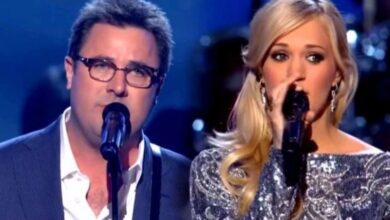Jan & Dean’s “Surf City” Brings West Coast Sound to the Top and Launches the Surf Rock Boom in 1963
In the summer of 1963, “Surf City” crashed onto the pop scene like a perfect wave, becoming the first surf rock single to reach No. 1 on the Billboard Hot 100. Recorded by Jan & Dean, the sunny Southern California duo already known for their harmony-driven style, the song captured the thrill of the beach lifestyle and ushered in an era where surf, sand, and song collided. More than just a novelty or a summertime anthem, “Surf City” helped define a sound that would dominate radio through the mid-1960s and influence generations of musicians to come. Its upbeat melody, playful lyrics, and carefree vibe offered a sharp contrast to the folk ballads and crooner hits still lingering from the previous decade.
Jan Berry and Dean Torrence met at University High School in West Los Angeles in the late 1950s. Both students were athletic and musically inclined, and they initially began singing together as a hobby. What began as playful harmonizing turned into a serious pursuit when their single “Baby Talk” hit No. 10 in 1959. Jan, a musical perfectionist and producer at heart, brought technical knowledge and studio innovation, while Dean offered a natural charm and visual appeal that helped define the group’s laid-back image. Together, they carved out a niche that bridged doo-wop, rock and roll, and the surf sound they would soon help pioneer.
The origin of “Surf City” is one of pop history’s most fascinating collaborations. Jan Berry was friends with Brian Wilson of The Beach Boys, and in an informal songwriting session, Wilson played an unfinished idea he had—just a couple of lines: “Two girls for every boy…” Berry loved it and asked to finish the song. Wilson agreed, later saying he didn’t think much would come of it. Jan ran with the concept, developing the verses and structure with co-writer Roger Christian, a DJ who shared a love for cars, surfboards, and the California dream. What emerged was a two-minute, harmony-rich celebration of a mythical surf haven where girls were plentiful and every wave was perfect.
The song was recorded in early 1963 at United Western Recorders in Hollywood, with Jan Berry himself producing the session—a rarity at the time for artists of his age. The recording featured members of the Wrecking Crew, the elite group of L.A. session musicians who played on countless hits throughout the 1960s. From the punchy drums and rolling bass to the chiming guitar riffs and layered harmonies, the sound was unmistakably Californian—bright, fast, and built for cruising. Dean’s lead vocal delivered the lyrics with breezy confidence, while Jan’s intricate production elevated the song far beyond its simple theme.
Released by Liberty Records in May 1963, “Surf City” made a splash almost immediately. It shot up the Billboard Hot 100 and reached No. 1 on July 20, 1963, holding that spot for two weeks. It also climbed to the top of the Cash Box chart and earned heavy airplay on both AM and FM stations nationwide. Notably, “Surf City” became the first surf-themed song to hit No. 1 in the U.S.—beating The Beach Boys to the top spot and sparking a friendly rivalry between the two acts that would continue through the decade.
Culturally, “Surf City” did more than entertain—it shaped a national perception of California as a paradise of endless summer. The song painted a vivid picture of youth, freedom, and adventure, appealing to teenagers dreaming of sun-drenched beaches and convertible rides along the Pacific Coast Highway. It also gave legitimacy to a genre that had been seen as regional or novelty-based. With “Surf City,” surf rock wasn’t just a fringe movement—it was mainstream. The single helped open the door for other surf-themed acts like The Surfaris, Dick Dale, and of course, The Beach Boys, who would soon dominate with a string of iconic hits.
For Jan & Dean, the success of “Surf City” marked the beginning of their golden era. It led to a series of charting singles, including “Drag City,” “The Little Old Lady from Pasadena,” and “Dead Man’s Curve.” The duo became regulars on television and national tours, and their comedic personalities and good looks made them fan favorites. Unlike many of their contemporaries, Jan & Dean leaned into their surf image with humor and a self-awareness that endeared them to audiences. Their success also gave Jan Berry more creative freedom to experiment in the studio, pushing boundaries with multi-track vocals and ambitious production techniques.
The influence of “Surf City” stretched far beyond Jan & Dean’s own catalog. It helped solidify the surf rock genre as a commercially viable style and inspired numerous imitators across the country. It also impacted how pop music could be packaged—not just as sound, but as a lifestyle. By tying music to a specific image and culture (surfing, hot rods, beach parties), Jan & Dean created a brand that extended into movies, fashion, and youth identity throughout the decade.
Many artists have paid homage to “Surf City” over the years. While it hasn’t been covered as frequently as some pop standards, its influence is embedded in the DNA of every surf-themed rock song that followed. Punk rockers like the Ramones and indie bands like Best Coast have all nodded to the California surf ethos that Jan & Dean helped popularize. In 1991, the city of Huntington Beach, California, officially adopted the nickname “Surf City USA,” further cementing the song’s cultural legacy—even amid a legal tussle with Santa Cruz over the name.
The early ’60s were a time of immense optimism, but that feeling wouldn’t last. Just months after “Surf City” topped the charts, America would be shaken by the assassination of John F. Kennedy, and the British Invasion would soon alter the course of popular music. In that context, “Surf City” now feels like a time capsule—a snapshot of American youth just before everything changed. For Jan & Dean, the transition was especially poignant. In 1966, Jan Berry suffered a near-fatal car crash that left him with brain damage and cut short the duo’s rise. Dean carried on solo for a time, but the duo would never fully return to their previous momentum.
Still, the legacy of “Surf City” endured. It remained a fixture on oldies stations, beach party compilations, and summer-themed playlists for decades. In 1998, Jan & Dean were inducted into the Vocal Group Hall of Fame, a nod to their contribution not only to surf rock but to the broader tapestry of American pop music.
Musically, “Surf City” helped pave the way for more ambitious pop production. Jan Berry’s layered arrangements and use of top-tier session players anticipated the techniques that Brian Wilson would take to new heights with Pet Sounds. The song’s mix of simplicity and complexity—easy on the ears but rich in structure—offered a blueprint for how fun music could also be artful.
In the end, “Surf City” wasn’t just about waves or girls—it was about possibility. It captured a dream of youth, freedom, and sunlit adventure that still resonates today. For Jan & Dean, it was the wave that lifted them to national stardom. And for listeners across generations, it remains a joyful ride through a world where summer never ends and the music is always turned up loud.



